Age Seventeen: Chinese Democracy Must Have Chinese Features
223. Totalitarian
Totalitarianism is a system of government where the rulers seek total control over every aspect of society. Individuals have no rights that the government must respect, and citizens are commanded to show absolute loyalty to the leaders and their ideology. Totalitarian states attempt to control not just political life, but also businesses, churches, and civic institutions like charities and social clubs. They even try to control what people think in the privacy of their own homes including their choice of cultural expressions such as music and literature. This idea was first put into full practice by Benito Mussolini in Italy after he came to power in 1922. As Mussolini said: “All within the state, nothing outside the state, nothing against the state.” He described this as “totalitario.”
An influential analysis of totalitarianism is the book Totalitarian Dictatorship and Autocracy, by Carl Friedrich and Zbigniew Brzezinski. The authors argue that totalitarianism is defined by six main characteristics. First, there is an official national ideology that motivates and justifies the extreme actions of the government. This could be a religious belief system, a political philosophy, or a set of ideas about race and biology. Second, there is a single extremely powerful leader, who is usually personally charismatic. The leader only tolerates his own political party, while prohibiting opposition parties. Third, the government uses modern science and technology to control the population—such as with psychology, surveillance, and powerful weapons. Fourth, the government controls mass media and communication, so that it is very difficult for people to access ideas that the government doesn’t want them to hear. Fifth, the government disarms the population to make rebellion impossible. Sixth, the government seeks total control of the economy, and forbids citizens to work in the ways they prefer.
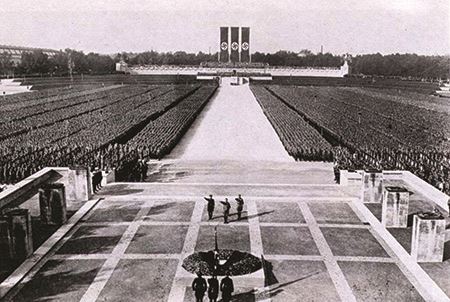
Nazi Party rally in Nuremberg, 1934. Totalitarian governments try to awe their citizens with dramatic spectacles designed to make them feel personally insignificant compared to the state
In her landmark book The Origins of Totalitarianism, historian Hannah Arendt also observed that terror is an essential feature of totalitarian government. Totalitarian leaders try to create the illusion of unanimity, so that citizens feel that everyone else supports the regime. Common ways of doing this include staging large and spectacular public parades and ceremonies, forcing people to repeat or chant proregime slogans, and punishing people who say things critical of the government. The result is that people are afraid to speak out, and since no one is speaking out, everyone else thinks that they are alone in their opposition. This creates a cycle of fear and silence, which convinces people that resistance is both dangerous and futile.
Totalitarianism is often confused with authoritarianism, but there are important similarities and differences. Similar to totalitarianism, authoritarianism describes a political system where the rulers do not respect civil rights, and bend the law to reward friends and punish enemies. Authoritarian regimes usually suppress political opposition, deflect public dissatisfaction onto scapegoats like foreigners or minorities, and intimidate the population in order to keep a firm grip on power. On the other hand, authoritarians lack the well-defined national ideology of totalitarians. They usually do not try to take over civic and cultural life and control people’s personal beliefs. And although they may interfere in the economy, they don’t seek to bureaucratically plan what every individual worker does. Thus, totalitarianism is more extreme than authoritarianism, and more intrusive into citizens’ private lives.
Historical examples of totalitarian regimes include Fascist Italy, Nazi Germany, and the Soviet Union. They all met the criteria proposed by Friedrich and Brzezinski, but did so with major differences in their ideologies. For example, Italy and Germany had extreme right-wing belief systems. They justified atrocities in the name of reclaiming historical greatness, or struggle between racial groups. On the other hand, the Soviet Union justified its crimes with the language of class struggle and the need to sweep away obstacles to communism and equality. All these ideologies gave people a feeling of belonging to something greater than themselves, and a sense of higher purpose. They told citizens that the nation was more important than the individual, and that this made it acceptable to persecute and kill anyone who dissented. It is this sort of thinking that made the Holocaust possible, and was a key factor in causing World War II. Thus, as described in more detail in the entry for Hitler’s “Final Solution,” my family’s history, and that of my wife Sonya, is closely tied to the effects of totalitarianism.
Although totalitarianism is mainly a thing of the past, it is not completely extinct. North Korea is a classic example of a modern totalitarian regime, and is regarded as the one of the most repressive countries in world history. The state prevents its citizens from hearing news from the outside world, and strictly bans social media. For this reason, it is called the “Hermit Kingdom.” The country’s Juche (self-reliance) ideology requires full mobilization from the population to support the armed forces. Even while some people are literally starving to death, North Korea maintains one of the largest militaries in the world. The humanitarian catastrophe is enormous.
![]()
In the alternative reality of Danielle: Chronicles of a Superheroine, when fifteen-year-old Danielle converts the Communist Party of China to the National Service Corps, she hopes that this will give its members a productive outlet for their energy. She appoints her old opponent, Former Premier Dingxiang Zhongfa, as Minister of the Election Commission. But she is disappointed to learn that Zhongfa and his supporters are interfering with free elections by barring candidates they find unsuitable. This is because they feel “Chinese democracy must have Chinese features.” Liu tells Danielle that this is to be expected because totalitarianism is so deeply ingrained in the Communist Party/National Service Corps, it would, therefore, have a hard time understanding democracy. Danielle corrects Liu, saying that “authoritarian” is the right description, because the People’s Republic of China hadn’t been truly totalitarian since the reforms of Deng Xiaoping in the 1980s.
See entries for Authoritarian, Hitler, Mussolini, Trains Leaving on Time in World War II Italy, Hitler’s FInal Solution, Holocaust, Mao Tse-tung, Chinese Communist Party, and Deng Xiaoping.
How You Can Be a Danielle and combat totalitarianism in the world.
224. Authoritarian
Authoritarianism refers to governments where the leaders do not have to respect the rights of the people, and the people cannot freely choose to replace their leaders. This is contrasted with liberal democracy—where the government generally respects the rights of the people, even when it is inconvenient to do so, and where the people can choose new leaders through fair elections. Another way of looking at authoritarianism is that it replaces the rule of law with the rule of a limited group of powerful leaders. This means that instead of everyone having to follow the same rules, the leaders can act arbitrarily to reward their friends and punish their enemies.
The other major feature of authoritarianism is that the leaders use the power of the government to suppress dissent. This can take many forms, ranging from mild to extremely harsh. For example, in mildly authoritarian regimes, the rulers may use the bureaucracy of government to harass people who criticize them. They might have their passport applications delayed for no reason, or be heavily fined for minor infractions that everyone else gets away with. In more extreme cases, authoritarian leaders arrest people who speak out against them, and may seize their property, punish their families, torture them, or even kill them.
Historically, almost all societies were authoritarian by today’s standards. In the kingdoms and empires of the ancient and medieval eras, people who criticized the rulers were usually punished. In those political systems, citizens either had no rights at all, or governments only respected those rights when they felt like it. In present times, though, political conditions have improved dramatically. A majority of the world’s population can now participate in elections, and there is a strong movement for human rights around the globe. Still, about 40 percent of the earth’s population lives in significantly authoritarian countries, so there is much progress that still needs to be made.
Every regime is unique, and is shaped by the circumstances of its own country. But there are some common features shared by many authoritarian regimes. One of the most distinctive is persecution of journalists. When reporters are able to investigate abuses by government leaders and inform the people about them, opposition to the regime can become so strong that the regime may be overthrown. To prevent this, authoritarian leaders try to intimidate journalists and disrupt citizens’ access to independent and accurate media sources. Instead, they often create a state-run news source that feeds the people propaganda in support of the regime. This propaganda tries to convince citizens not to trust journalists, calling them liars and agents of foreign powers. This has recently been a common pattern in Russia, for example, and its leader Vladimir Putin has been accused of ordering the assassination of several journalists who had been critical of him.
Another common trait of authoritarians is using real or imaginary crises to restrict civil rights. In present times, even highly authoritarian regimes usually at least claim that their citizens have rights under the law. But when there is a crisis—such as a terrorist attack, a rebellion, or a natural disaster—the leaders claim that it is necessary to temporarily suspend those rights until the emergency can be resolved. At such times, citizens may be afraid, and often go along (or have no choice). For example, in the Philippines, the authoritarian leader Ferdinand Marcos used a series of attacks by communist guerrillas to justify declaring martial law. This meant that ordinary civil rights were suspended, and the military was free to commit human rights abuses. Marcos used these powers to have many of his political opponents arrested. He kept the Philippines under martial law from 1972 to 1981.
In many cases, authoritarian leaders try to scapegoat racial, ethnic, political, or religious minorities. They claim that a minority group is the real reason for many of the country’s problems. This distracts the people from criticizing the leaders and noticing their failures. Scapegoating minorities also makes people more willing to let the government take on additional powers. And once the scapegoat minority loses its civil rights, the people become more willing to let other groups be persecuted.
It is also common for authoritarian leaders to blur the line between their own personal economic interests and those of the nation. They may build themselves lavish palaces with public money, or use funds from taxpayers to reward loyal supporters. In Saudi Arabia, for example, the royal family enjoys gigantic personal wealth thanks to the country’s oil and other natural resources. Similarly, authoritarian groups often blur the line between their own political interests and the security interests of the state—such as claiming that peaceful political opposition groups are actually terrorists that must be mercilessly suppressed. For example, the People’s Republic of China has been widely criticized for its claims that the Falun Gong spiritual movement is a threat to national security.
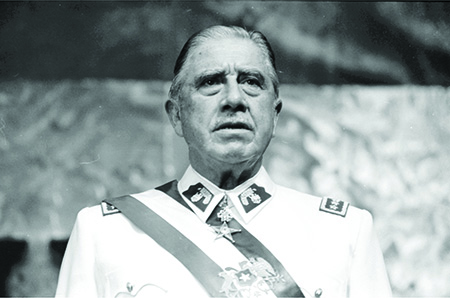
Augusto Pinochet, the authoritarian leader of Chile from 1973 until 1990
In countries where there is a democratic system already in place, authoritarians often try to change the election laws to secure their grip on power. They might do “Gerrymandering,” which involves drawing the boundaries of political districts in an unfair way, so their opponents are at a significant disadvantage in elections. Or they might change the locations of polling places, or the hours they are open, to make it harder for certain groups of people to vote. Or they could even change the law so it’s not secret who people vote for, making people afraid to vote for opposition parties.
Finally, when authoritarians take power in a country with an established constitution, they may ignore or alter the parts of the constitution that limit their power. For example, most constitutions specify some kind of separation of powers—meaning that government is divided into different branches, with no single branch holding all the power. Authoritarian leaders want all the power for themselves, so if there are other branches getting in the way of their plans, like a parliament or supreme court, they try to undermine their influence and independence. This may involve creating new and more powerful offices for themselves, or changing the constitution to remove limits on the number of terms they can serve in office. All this can be accomplished while still keeping up a pretense of democracy. Thus, there is more to simply holding elections for a truly effective democracy.
Authoritarianism is often compared with and confused with totalitarianism. Totalitarianism is an extreme type of authoritarianism with some very distinctive features. These include a major national ideology like communism or fascism, and attempts by the government to take over every aspect of civic life and the economy. By contrast, authoritarian leaders are usually content to leave citizens mostly alone, as long as they don’t actively oppose the regime. Instead, they focus on expanding their own power and defending it against potential threats and rivals.
![]()
In the alternative reality of Danielle: Chronicles of a Superheroine, when Danielle learns that former premier Dingxiang Zhongfa is trying to thwart her reform agenda as president of China, Liu says that this is to be expected. He tells Danielle that totalitarianism is so deeply ingrained in the old leaders of the Communist Party of China that they have a hard time understanding democracy. Danielle points out that “authoritarian” is the proper term to use, because the People’s Republic of China had not actually been totalitarian since Deng Xiaoping instituted major reforms during the 1980s.
See entries for Vladimir Putin, Totalitarian, Trains Leaving on Time in World War II Italy, Hitler’s Final Solution, Holocaust, Hitler, Mussolini, Stalin, Chinese Communist Party, Mao Tse-tung, and Deng Xiaoping.
225. Deng Xiaoping
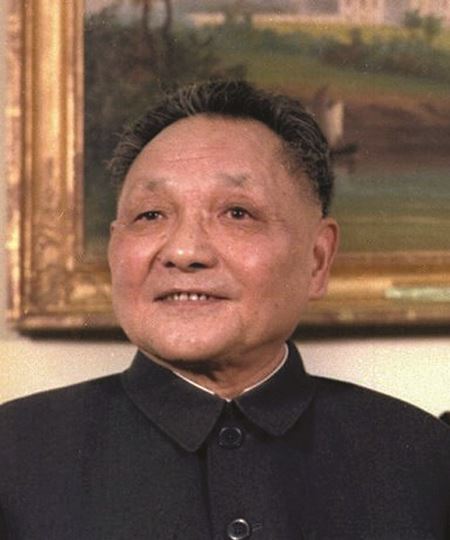
Deng Xiaoping, paramount leader of China from 1978 to 1989
Deng Xiaoping (1904–1997) was the principal leader of the People’s Republic of China from 1978–1989. He is best known for taking power two years after the death of Mao Tse-tung (1893–1976) and undoing many of his policies. While Mao had been a radical communist, Deng was more moderate, and made China relatively open to limited economic and political freedom. He resisted extensive political reform and maintained the centralized power of the Communist Party, however it no longer controlled all aspects of cultural life.
Born in Sichuan province, Deng grew up in a well-off family and received a solid education. As a teenager, he traveled to France for a work-study program with other Chinese students, and there he became involved in socialist and communist politics. When he returned to China, he supported the Communist Party of China, and rose through its ranks. In 1927, he survived the Shanghai Massacre, in which Chiang Kai-shek (1887–1975) and the nationalist Kuomintang faction violently purged communists and sparked the Chinese Civil War. By 1934, the war was going very badly for the communists, and Deng participated in Mao’s famous Long March to escape total destruction by the nationalists.
Following the communists’ ultimate victory in the civil war after the end of World War II, Deng rose through the ranks of the Party as an ally of Mao. Yet when the Cultural Revolution broke out in 1966, Deng lost power and was exiled to southeastern China, where he became a target of the fanatical Red Guards. Deng favored more liberal reforms and increased economic freedom, so the Red Guards viewed him as a “capitalist roader” and a threat to what they saw as a perpetual communist revolution.
In 1973, though, Deng was “rehabilitated” and brought back to positions of responsibility. After Mao’s death in 1976, Deng used skillful political maneuvering to gain influence, and within two years had become the most powerful person in China, even though formally he did not hold any of the most powerful offices in the Communist Party or the government.
As soon as his power was secure, Deng began a series of major reforms. His intention was to undo the excesses of the Cultural Revolution and repair the extensive harm it had caused to Chinese society. He allowed citizens greater freedom to criticize the government and express political opinions, in a movement that became known as the Beijing Spring. He also promoted greater economic freedom, allowing for a blending of capitalism and communism.
According to Deng, the Cultural Revolution idea that it was “better to be poor under socialism than rich under capitalism” was wrong. Instead, Deng said, “a basic contradiction between socialism and the market economy does not exist.” He even admitted that in order to bring prosperity to the whole Chinese people, the country would have to “let some people get rich first.” Deng called this new approach Socialism with Chinese Characteristics.
One of Mao’s most harmful actions was forcing China’s farmers into shared collective farms, and enforcing state control over every aspect of the economy. This made innovation and entrepreneurship impossible and led to widespread starvation. Deng reversed this policy, allowing farmers to have their own land and many workers to choose their own jobs. As a result, China achieved rapid economic growth. Foreign companies began to invest money in China, building factories to ship goods all over the world.
Yet Deng’s most famous action was implementing the One Child Policy. This was a rule that most Chinese citizens could only have one child, with exceptions for ethnic minorities and some other special cases. The policy was intended to create a more sustainable population. Deng feared that out-of-control population growth would outpace increases in agricultural production, leading to a repeat of the mass starvation that occurred under Mao. This fear was influenced by Western books like The Limits to Growth and A Blueprint for Survival, which many Chinese officials read with alarm.
The One Child Policy had many negative effects. The communists enforced the policy with forced sterilizations and forced abortions. Human rights organizations say that because boys are favored in traditional Chinese culture, when parents discovered that they were having a girl, they often had abortions or even killed the girls as infants. The result is that tens of millions of women are “missing” from the population, who would otherwise be expected to be adults by now. This leaves more than 30 million young men with little chance of finding women to marry.
The end of Deng Xiaoping’s time in power was also marred by the Tiananmen Square massacre. After more than a million prodemocracy protesters gathered in Tiananmen Square, Beijing in 1989, Deng authorized the use of force to disperse the crowds. Hundreds were killed, and many more wounded or arrested. Shortly after this incident, Deng went into retirement.
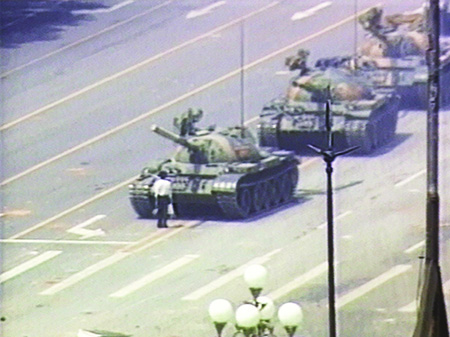
“Tank Man,” one of the most famous pictures in world history, depicts an unknown man standing in the path of Chinese tanks during the Tiananmen Square protests in 1989
![]()
In the alternative reality of Danielle: Chronicles of a Superheroine, when Danielle is eleven years old, she criticizes Deng’s One Child Policy, saying that it has been a disaster for girls. Later, when, at fifteen, Danielle is president of China, she converts the Communist Party of China to a National Service Corps. Soon, the party’s old leadership opposes Danielle’s reforms, and Dingxiang Zhongfa says, echoing Deng Xiaoping, that “Chinese democracy must have Chinese features.” Liu comments that this opposition is to be expected because the Communist Party was a totalitarian institution. Danielle corrects him that it was only authoritarian, and has not been totalitarian since the reforms of Deng Xiaoping.
See entries for Mao Tse-tung, Chiang Kai-shek, Kuomintang, Chinese Communist Party, Mao’s Long March, Central Committee of the Chinese Communist Party, Chairman of the Communist Party of China, China’s One Child Policy, Tiananmen Square, Totalitarian, and Authoritarian.
How You Can Be a Danielle and promote democracy in China.
226. Trains leaving on time in World War II Italy
When Benito Mussolini (1883–1945) came to power in Italy in 1922, he installed the ideology of fascism. Fascism is a political system that is a type of authoritarianism and totalitarianism, and is focused on a right-wing nationalist ideology. Italian fascism was about restoring Italy to the greatness of the Roman Empire, avenging past insults, and improving the country’s economy. At first, many Italians opposed Mussolini and the fascists because of their abusive and violent tactics, but Mussolini successfully created a perception that he “got things done.” The example he showed as evidence of this was that his government’s harsh measures had created greater efficiency, causing Italy’s famously disorganized train system to run more smoothly.
This perception made some of the Italian people more willing to accept the loss of freedoms they experienced under fascist rule. For ordinary citizens, the right to author newspaper articles critical of the government was not very important, because most people didn’t write newspaper articles. On the other hand, many people traveled frequently by train, and practical improvements to this system positively impacted their daily lives. This made them essentially say: “Yes, Mussolini is a cruel man, but at least he makes the trains run on time.”
Since then, trains running on time has been used metaphorically to refer to the effect of authoritarian and totalitarian governments. If they can achieve improvements to the daily lives of ordinary people, or even create the widespread perception of such improvements, those people will put up with even severe restrictions to their civil rights.
Subsequent research has shown that although Mussolini made the main railroad lines more efficient, many of the smaller railways remained chaotic. But because Mussolini created a powerful myth about himself and his fascist movement, people focused on the improvements to rail service rather than its shortcomings.
![]()
In the alternative reality of Danielle: Chronicles of a Superheroine, when Danielle is trying to figure out how to channel the energies of the former Communist Party of China away from opposing her reforms and toward a more useful activity, Claire jokes that they could work on making the trains leave on time. This is a deliberate reference to Mussolini. Danielle sees the seed of a good idea in this joke, and agrees that the National Service Corps should be directed to help create economic growth in rural areas.
See entries for Authoritarian, Totalitarian, Mussolini, Hitler, and Chinese Communist Party.
How You Can Be a Danielle and combat totalitarianism in the world.
227. Mussolini
Benito Mussolini (1883–1945) was the dictator of Italy for most of the period from 1922 until 1945, and a close ally of German dictator Adolf Hitler. Mussolini led a totalitarian movement known as fascism, and ruthlessly suppressed his political opponents. He led Italy into World War II as an ally of Germany and Japan, and was responsible for many war crimes until being captured and executed by an Italian antifascist group.
Mussolini was born in a relatively poor socialist family in northern Italy, and while growing up he showed intelligence and ambition, but also a rebellious streak. As a young man, he became a socialist activist, and agitated in both Italy and Switzerland for workers to oppose capitalism. During this stage of his life, he saw the world through the lens of Karl Marx’s philosophy about the conflict between social classes. Mussolini believed that workers and poor people in different countries had more in common than poor people and rich people in the same country. He was a charismatic speaker, and people began to notice his leadership and ability to inspire people. He also wrote and edited socialist newspapers, which spread his views throughout Italy.
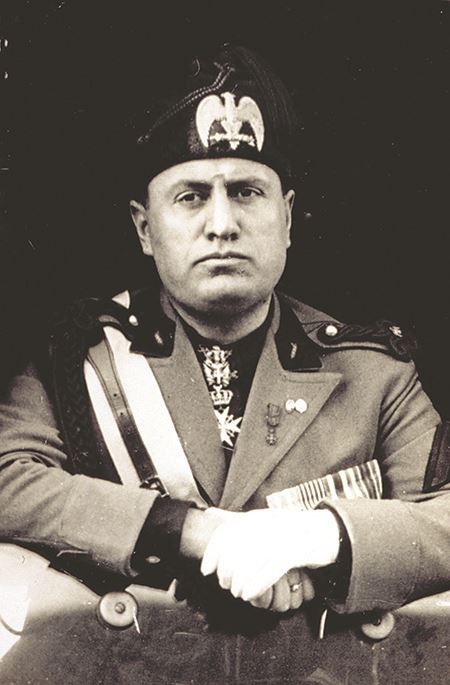
Italian fascist leader, Benito Mussolini, October 1923
When World War I began in 1914, Italy was still neutral. At first, Mussolini opposed his country joining the war. He argued that war is a conflict between rich people but that poor people on both sides suffer its consequences. But his views soon shifted. Mussolini changed his mind about the war, and said that Italy should join on the side of the Allies (also known as the Triple Entente), because defeating the Central Powers of Germany, Austria-Hungary, and the Ottoman Empire would encourage workers in those countries to rise up in socialist revolutions against the old monarchies. Mussolini also saw the war as a way to punish the Austrians for perceived wrongs against Italy, and reclaim Austrian-ruled territories that had large Italian-speaking populations. His strong support of the war caused a bitter disagreement with many of his fellow socialists, who were still pacifists. They decided to expel Mussolini from their political party.
In response, Mussolini started his own pro-war newspaper and a political group to advocate joining the Allies. Instead of saying that social class was the most important factor for uniting people, he now said that nationality and ethnicity were more important. He claimed that Italians were a superior people, and that they had to avenge insults by other nations. He soon joined the military himself, and served on the frontlines in the sharpshooters branch until he was wounded in combat.
After the end of World War I, Mussolini organized his political followers, including many military veterans, into a new group called the Fasci Italiani di Combattimento, which roughly translates as Italian Combat Bands. The word “Fasci” was a reference to fasces, which were bundles of sticks carried by the attendants of ancient Roman officials as symbols of authority. Individually, each stick can be easily broken, but when many are bound together tightly, they are almost impossible to break. Mussolini had a similar vision for society. If everyone were bound together tightly by nationalism and patriotic spirit, and if dissent could be suppressed, he believed the nation would be almost impossible to defeat. Mussolini called this idea fascism.
In post-war Italy, this message resonated with people strongly. The peace treaty had not given Italians what they felt they deserved, and the economy was struggling. Many citizens blamed left-wing socialists and trade unions for the conflict and political division gripping the country. Many also blamed moderates and intellectuals for government corruption and inaction. Mussolini and the fascists said if they were given power, they would enforce law and order, eliminate corruption, and restore Italy to the greatness of ancient Rome.
Mussolini’s fascists wore distinctive black shirts as a uniform, so they became known as Blackshirts. The Blackshirts acted like a private army. They threatened Mussolini’s political opponents, and beat up supporters of rival parties. When politicians won local elections, they were forced to go along with the fascists’ demands as a result of threats of violence by the Blackshirts. Inspired by Mussolini’s powerful speeches, thousands and thousands more men signed up to join the Blackshirts.
In 1922, Italy’s trade unions called for a general strike, where workers across all industries in the country would stop working at the same time. Wealthy and middle-class Italians were frightened by the economic disruption, a situation that Mussolini was able to take advantage of. He mobilized tens of thousands of Blackshirts, and announced that they would be marching toward Rome from all over Italy, demanding that the liberal prime minister resign. The prime minister tried to declare a state of emergency and send the army to stop the fascists, but Italy’s king, Victor Emmanuel III, refused to sign the order. The king was afraid that using force to stop the so-called March on Rome would trigger a civil war—and he was probably right. Mussolini demanded that the king invite him to become prime minister, and seeing this as the only way to resolve the crisis, the king accepted.
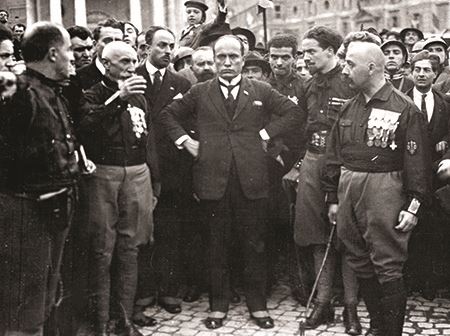
Mussolini and fellow Blackshirt leaders at the time of the March on Rome
Soon after he became prime minister, Mussolini was able to pass laws giving himself emergency powers. Over the following years, he made those powers permanent and expanded them even further. This quickly transformed Italy from a democracy to a totalitarian dictatorship.
Fascism is one of the classic examples of totalitarianism because it sought to control every aspect of society. Mussolini banned opposition parties, took over the media, and harshly punished anyone who criticized him. The fascists created a new economic model that merged industry with government. This was a major change from the normal arrangement, where corporations negotiate with labor unions to agree on wages and working conditions, with government helping to enforce the agreement. Instead, Mussolini reorganized most of the economy under government control. Workers lost most of their rights, and factory owners were forced to follow orders from the regime. This merging of industry and government became known as corporatism. In addition to corporatism, Mussolini opposed free trade, and wanted to make Italy economically self-sufficient.
Meanwhile, Mussolini worked to unify political support for fascism throughout the country. Many of Italy’s conservative Catholics had opposed him, because Mussolini was probably an atheist and had made public statements claiming that religion is nonsense. But Mussolini won them over by passing pro-Catholic laws and promising to restore law and order following the period of strikes and violence. In 1929, he made a historic deal with the Catholic Church, where he agreed to recognize the independence of the Vatican City, which in return acknowledged the united state of Italy for the first time as the legitimate government of Rome. Similarly, Mussolini ordered a large military buildup, and gained the support of many people in the army and navy who had previously opposed him.
A major tool Mussolini used for mobilizing political support was the media. He knew how to use radio very effectively, communicating directly with the people and stirring up their emotions. He created a cult of personality around himself, where he was portrayed in the government-controlled press as a national hero and an almost godlike leader. Photographers followed him around, taking flattering pictures of him that made him look like a tough leader and a man of action. These were reproduced millions of times in Italian newspapers, and gradually people came to believe the myths Mussolini carefully crafted about himself. One of the most famous pieces of Mussolini’s propaganda was the idea that fascism had made the country much more efficient, and that he had made the trains in Italy run on time. Even though this wasn’t completely true, most people believed it, and it helped them accept the loss of freedom that fascism required.
Mussolini created fascist ideology from a mix of different philosophies and belief systems. He included some elements of socialism, but also incorporated racist pseudoscience about the genetic superiority of the Italian people, and the writings of Friedrich Nietzsche (1844–1900), who said that power and ambition were more important than ethics and morality. Nietzsche created the idea of the Übermensch, a naturally superior “superman” with the right to rule over others, and the Untermensch, who were subhuman groups naturally destined to serve the more advanced races. Mussolini used these theories to make Italians feel good about themselves and justify the violence of fascism. Mussolini was also obsessed with the idea that Italy had to increase its birthrates, and pressured Italian women to have many children. He hoped this would eventually provide enough young men to meet the army’s needs.
In 1933, another fascist-style movement came to power to the north. Germany’s National Socialist German Workers’ Party, known as the Nazis, were a totalitarian movement that had similar ideas to Mussolini about race and nationalism. The Nazis’ charismatic leader Adolf Hitler (1889–1945) was like Mussolini in many ways, even including their preferred nicknames. Mussolini’s cult of personality called him Il Duce (Italian for “the Leader”) and Hitler was known as Der Führer (German for “the Leader). Hitler and Mussolini soon realized how much they had in common, and signed a treaty between their two countries in 1936. Mussolini proclaimed that from then on, the rest of Europe would revolve around a “Rome-Berlin axis.” This term stuck, and after Germany and Italy entered a formal alliance in 1939, they became known, along with their other ally Japan, as the Axis.
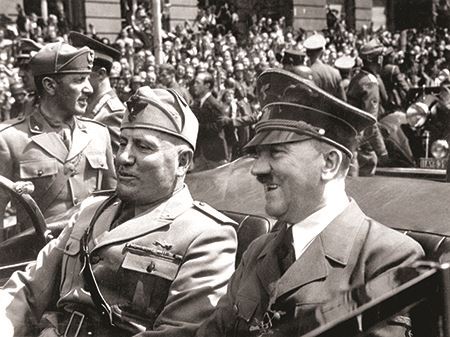
Mussolini with Adolf Hitler in 1940. The two leaders had similar ideologies, and both died in utter defeat just days apart at the end of World War II
Despite joining this alliance, Mussolini was worried about going to war. He desperately wanted to create a large colonial empire for Italy in Africa, but almost the whole continent was already divided between rival European countries. So in 1935, he had invaded one of the only independent African nations left: Ethiopia. The invasion was a great success, but Ethiopia had a very weak military. Hitler was planning a major war in Europe, and Mussolini knew that Italy wasn’t ready. When Hitler invaded Poland in 1939, the United Kingdom and France declared war on Germany, triggering World War II. At first, Mussolini did not join his German allies in the war, as he had promised to do. But by 1940, it was looking as if Hitler would sweep to easy victory. German tanks rolled into Paris, and the French government was on the brink of collapse. Finally, Mussolini decided that the Allies were going to lose, so he joined the war hoping to steal territory from France with low risk.
This strategy worked well for about a year, but soon the Allies went back on the offensive in the Mediterranean. The British navy was much stronger than the Italian fleet, and cut off supply lines to Italian troops fighting in North Africa. By 1942, the outnumbered and undersupplied Italians had suffered major defeats in Libya, and in 1943, the Allies invaded the large Italian island of Sicily. Shortages of food and living supplies were starting to affect the civilian population in Italy, and they became disillusioned with the war. When the Allies invaded the Italian mainland later that year, the remaining support for Mussolini collapsed. The Grand Council of Fascism voted him out of office and the next day, King Victor Emmanuel III had him arrested.
Mussolini was kept under guard in a remote mountain hotel, but German special operations forces staged a daring rescue mission. While the Allied armies slowly advanced up the Italian peninsula from the south, Germany put Mussolini in charge of a new puppet state in the north, called the Italian Social Republic. Mussolini had little power at this point, but he continued cooperating with German persecution of Jews in Italy. These included mass killings, known in Germany as the “Final Solution,” (also called the Holocaust or the Shoah) which resulted in the deaths of about six million Jews and about nine million others.
By the spring of 1945, the Allies, along with Italians who had switched sides, were moving into Northern Italy. The Italian Social Republic was crumbling, and Mussolini fled for his life. Along with his mistress Clara Petacci, he was recognized while traveling in disguise and captured by members of a left-wing Italian militia. They were both executed and their bodies hung upside down in public, and their deaths were celebrated by cheering crowds. Mussolini’s legacy is now seen as shameful in Italy, and he is remembered as one of history’s worst dictators. People often study Mussolini’s rise to power to see how charismatic leaders undermine democratic societies and hopefully to learn how to prevent similar figures from rising to power in the future.
![]()
In the alternative reality of Danielle: Chronicles of a Superheroine, when Danielle is president of China, she is frustrated that the former Communist Party of China is thwarting her reform programs. She tries to figure out a way to channel their energies into something more productive. Claire makes a joking reference to Mussolini, saying that the old communists could work on making the trains leave on time. Danielle sees a good idea in Claire’s joke, and directs the National Service Corps to help create economic growth in rural parts of the country.
See entries for Totalitarian, Authoritarian, Trains Leaving on Time in World War II Italy, Hitler, Special Operations Forces, Hitler’s Final Solution, Holocaust, and Chinese Communist Party.
How You Can Be a Danielle and combat totalitarianism in the world.
228. Shanghai
Shanghai is the largest city in China, with a population of over 24 million. The city lies on the coast of the East China Sea near the mouth of the Yangtze River, and is the world’s busiest cargo port. In this way, Shanghai acts as a key outlet for Chinese trade with the rest of the world. Goods made in factories throughout China are loaded onto container ships in Shanghai and transported to every continent. The city is also a major hub for China’s growing finance, advertising, and media industries.
For most of China’s history, Shanghai was a small agricultural community. But in the nineteenth century, it became the main center for trade between the Chinese and European countries. Foreign imperial powers dominated Shanghai, and the British, French, and Americans all set up their own zones of control, which lasted for decades. This made Shanghai a site of vibrant cultural exchange, and it was one of the first cities in China to adopt revolutionary technologies like electricity.
In 1927, Chiang Kai-shek of the nationalists ordered a series of violent purges against Chinese communists in Shanghai. This event, which came to be called the Shanghai Massacre, sparked the Chinese Civil War, which was fought off and on for the next 23 years. When the Imperial Japanese invaded China in 1937, they conquered Shanghai in a brutal battle and occupation that killed hundreds of thousands of people. When the city was liberated in 1945, it enjoyed a brief return to relative freedom, but in 1949 was taken over by the communists, who carried out severe political persecutions.
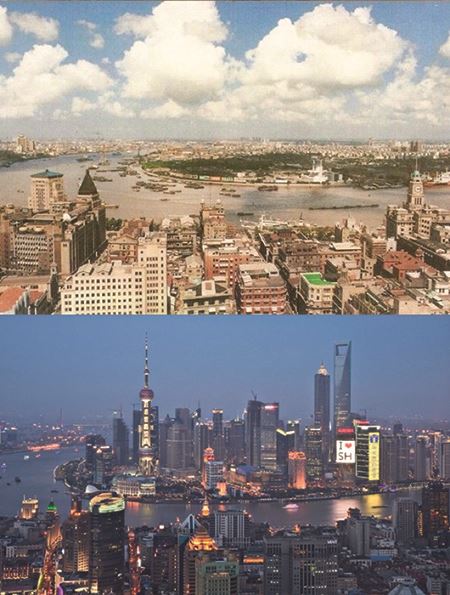
Roughly the same view of Shanghai, in the early 1990s (top) and in 2010 (bottom)
For the first several decades of communist rule, Shanghai did not thrive. It had developed as a city of trade and industry, and Chinese leader Mao Tse-tung (1893–1976) was strongly opposed to capitalism. Soon after Mao’s death, though, Deng Xiaoping (1904–1997) took power, and led China through a series of major reforms. Deng allowed a limited increase in political freedoms, and made the country significantly more open to capitalism. As China became more capitalist, Shanghai became the hub of the country’s new spirit of innovation and entrepreneurship.
Between the 1980s and today, Shanghai has built a massive skyline of cutting-edge skyscrapers, including the 2,073 foot tall Shanghai Tower, which is the second tallest building in the world. Other super-tall towers in Shanghai include the World Financial Center (1,614 feet), and Jin Mao Tower (1,380 feet).
Other landmarks in Shanghai include the distinctively shaped TV-broadcasting tower called the Oriental Pearl Tower, the Shanghai Museum with its collections of Chinese cultural artifacts, and the ancient Buddhist holy site of Jing-an Temple.
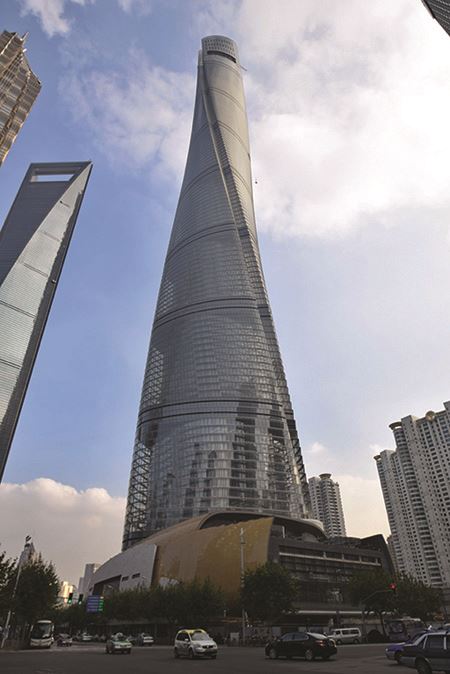
Shanghai Tower, the second-tallest building in the world, behind only the Burj Khalifa in Dubai
![]()
In the alternative reality of Danielle: Chronicles of a Superheroine, as a result of Danielle and Liu acting in support of democratic reforms in China, Liu is arrested. Danielle sneaks into Shanghai and after a series of conflicts and maneuvers is elected chairgirl of the Communist Party of China. At age fifteen, she becomes the first democratically elected president of China. While she is president of China, she encourages the creation of special economic zones to promote prosperity in rural parts of the country. Danielle is inspired to do this by looking at the growth achieved in Shanghai due to the former communist government fostering capitalism there.
See entries for Chiang Kai-shek, Kuomintang, Chinese Communist Party, Mao Tse-tung, and Deng Xiaoping.
How You Can Be a Danielle and promote democracy in China.
229. Learn by doing
“Learn by doing” is an approach to education that emphasizes active engagement and practical experience. The basic idea is that actually using skills is a better way of developing them than simply being taught about them in the abstract. Children (and adults) will also learn other basic skills while they are focused on a practical and beneficial goal.
A helpful analogy is riding a bicycle. You can read a book about learning how to ride a bicycle, and when you’ve finished, you might be able to explain in detail how to pedal, steer, and shift your weight while turning. But until you get on a bike for the first time, that knowledge is just theoretical. The experience of actually riding a bike is the best way to learn how to ride better. Riding teaches your brain subtle tricks that you can’t even put into words. Neuroscientists call this “procedural memory.” This is contrasted with “declarative memory,” which lets you remember facts and express them in words. Learning by doing not only helps build skills through procedural memory, but can also help you make deep and meaningful associations between the ideas you hold in your declarative memory.
For most of human history, learning by doing was the dominant mode of education. Children learned how to farm by helping their parents with farming. They learned to cook by helping their parents cook, and learned poetry by composing and reciting poems. Young people learned trades and professions by getting apprenticed to experts who had already mastered those occupations. They would gradually do more and more of the work, under close supervision of the expert, until they had a firm command of all the necessary skills.
Since the nineteenth century, though, there has been a dramatic shift away from learning by doing in most developed countries. As education became classroom-focused, teachers and college professors gave lectures about their subjects, and students were expected to sit quietly and take notes. They had to memorize lists of places, names, and dates. Classes spent a lot of time on repetition and shortcuts for remembering facts, a process known as “rote” learning. Tests rewarded students for repeating information in exactly the form the instructor gave it, but often failed to reward students for knowing how to apply that information, or understanding the relationships between different pieces of information.
One of the first critics of rote learning was the American philosopher and educator John Dewey (1859–1952), who argued that education should include more active participation by students. Dewey advocated a practical approach to education, where young people could develop the knowledge and skills they would need in real life. These ideas influenced alternative approaches to education that also focused on some form of learning by doing. For example, the Montessori schools movement encourages children to learn new skills and ideas by physically interacting with educational materials and discovering how they work. Instead of merely memorizing rules in geometry, they can handle 3D objects and get a deeper understanding of how those rules work.
Even in subjects where it is not possible to directly participate in the issues being studied, learning-by-doing education can still be helpful. For example, teachers can let students feel as though they are participating in history through dramatic readings, debates, and role-playing. One educational method that is growing in popularity is “gamification.” This means teaching students about complex ideas by incorporating them into games—sometimes played on computers, and sometimes in the form of board games or social games. Games assist learning by helping our brains encode new information in several different ways at once, all of which reinforce each other. Playing games engages multiple senses, and requires creativity, judgment, and pattern recognition. In my 2012 book How to Create a Mind, I explain my Pattern Recognition Theory of Mind (PRTM), which shows how pattern recognition is key to the way our minds work. The natural experimentation and problem solving of gameplay lets students recognize subtle patterns and understand subjects on a deeper level than rote learning. In addition to pattern recognition, the fun and frustration of playing educational games adds an emotional layer to our memories of them, which neuroscience shows helps us retain those memories better.
The most powerful form of learning by doing is for students to engage in longterm projects with a socially useful purpose, such as overcoming disease, hunger, and poverty. Whether the projects succeed or fail, the student is likely to acquire significant knowledge and skills. This is the philosophy of Singularity University which I cofounded with Peter Diamandis in 2008. Eighty students in each graduate studies program (in 2016 they were from 36 countries) form small teams of three to eight students and take on global challenges.
![]()
In the alternative reality of Danielle: Chronicles of a Superheroine, Danielle’s school is called the Stern School, and is named after the Stern Schule, which was founded by my great grandmother Regina in Vienna in 1868. The Stern School’s motto is “Learn by Doing,” and Danielle’s school assignments are directed at solving real-world problems. When Danielle becomes president of China, she has her sister Claire lead a learning-by-doing revolution in Chinese education. This revolution causes resistance by the old Chinese authorities, but Danielle intervenes to help the learning-by-doing program succeed.
See entries for Stern Schule and Plasticity of the neocortex.
230. Power from the barrel of a gun
When the Communist Party of China was founded in 1921, its leaders were divided over whether to focus on political advocacy or violent revolution. The Party’s first leader, Chen Duxiu, preferred a political approach that sought broad support from the middle classes. His rival Mao Tse-tung (1893–1976) believed that armed struggle by the peasant farmers was the most effective approach. Initially, Chen’s strategy led the communists to ally with the nationalist forces of Chiang Kai-shek (1887–1975), but in April 1927, Chiang turned against the communists in a series of violent purges.
The purges were known as the Shanghai Massacre after the main site of the killings, and threw the communists into panic. When the Party’s leadership had an emergency meeting on August 7, 1927, they denounced Chen’s political approach, and supported Mao’s strategy instead. In a speech at that meeting, Mao argued that the Party “should put much emphasis on military affairs; this is because political power grows out of the barrel of a gun.”
Eleven years later, at a plenary session of the Sixth Central Committee of the Chinese Communist Party in 1938, Mao repeated the phrase to a wider audience. He also used a similar expression speaking of the communists’ successes in southern China, when he said: “All good things grow out of the barrel of a gun.” These quotes were circulated widely, and expressed Mao’s belief that the only way the communists could gain control of China was through fighting. This is exactly what happened, and after the Imperial Japanese were defeated in 1945, Mao resumed the terribly bloody civil war against Chiang Kai-shek and the nationalists. After forcing the nationalists to flee to Taiwan, Mao officially founded the People’s Republic of China in 1949.
This quote was featured in the 1964 book Quotations from Mao Tse-tung, better known as The Little Red Book of Mao. Over a billion copies of the book were printed, and all Chinese people were encouraged to keep it with them and study it closely.
Sometimes the expression “power from the barrel of a gun” is used outside Chinese contexts to refer to the idea of “might makes right”; meaning that despite rules of ethics and morality, it is only the threat of violence that gives people real political power. One of the goals of liberal democracies is to reverse this concept, so that “right makes might.” For example, when a country’s laws are just and its courts function properly, people’s rights are enforced by the full power of the government.
![]()
In the alternative reality of Danielle: Chronicles of a Superheroine, when Danielle becomes president of China at age fifteen, she encourages entrepreneurship and innovation. When a group of college students create a new communication app that can bypass the nationally controlled messaging system, former premier Dingxiang Zhongfa manages to get a court order to shut the app down. In a 3D video conference about this with Danielle, Liu observes hopefully that “at least the fight is now with words.” He means by this that Zhongfa is using the court system instead of the violence that Mao had advocated.
See entries for Mao Tse-tung, Chairman of the Communist Party of China, Chiang Kai-shek, Kuomintang, Chinese Communist Party, Authoritarian, and Central Committee of the Chinese Communist Party.
How You Can Be a Danielle and promote democracy in China.
